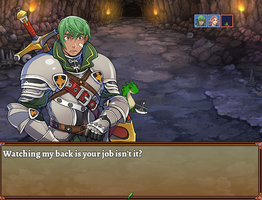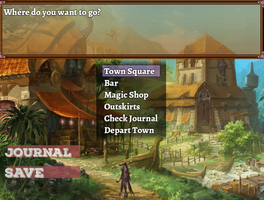Post Mortem



I’m writing this from a Barnes and Noble. I just finished Dungeon drop about an hour ago, after working on it for about 5 hours today. What I thought would be a very short (2 – 3 hours) ended up being 5 hours. Incredible.
I was really pleased overall with this game. It’s difficult at this time to even really address which parts of it I really felt good OR bad about. The things that went really well or the things that Things I felt could be better. Some initial thoughts on future things I’d like to try.
- Board Game Dungeons (Ala Regalia and Unlimited Saga) -- I found out during the process of working on this game that the random encounter system came from an old hexagonal board . game version pre – DND. Before DnD there was a game that I think was called Dungeon Guild or something like that. In that game, whenever a player stepped on a hexagon or certain hexagons, there was a random chance that something could happen: traps, treasures, and ofcourse, random monster encounters. I imagine there was a lot more to it than that, but it’s interesting to consider – especially since most players today hate random encounters. When you consider it from that system random encounters were a very different experience. They were almost like a negative possibility among any number of positive or neutral possibilities – not a negative possibility always waiting to happen which is what the random encounter has evolved into. I like the “board game system” idea behind Regalia and Unlimited Saga though because a lot of it relies on storytelling. So if a player lands on one square a story may be told to him – if he lands on another square it may be treasures – if he lands on another one it may be a trap or an encounter. There’s a sense of discovery I suppose that happens there that we really seek to recreate when we draw out a dungeon at large but has gotten really lost in the repeated reiteration of the video game dungeon. Tl;dr what we’re really trying to do is create a sense of discovery, curiosity, and exploration – random encounters exist to support that feeling, not random encounters for random encounters’ sake.
- Experience system and resources – The fine balance is how do you reward players with experience. Better still perhaps how do you create a progress system. What I’ve learned from watching dragon quest which really shaped the way I’ve created this game – is that you’re actually always more or less leveling around 5 – 10 levels depending on what the developer wants you to do in the space. In that regard encounters are really cool because you don’t have to make them grind-y – you’re just trying to get the player to enjoy the fruits of his labor in building up the characters. I mean the mechanic largely has to do with combat. So as a result, you want the player to engage with combatbut not to the point that he gets burned out.
Pros:
- Build the mechanic and you can basically add whatever you want. In a JRPG at this time – at least for me – combat is largely one of the most important parts of the game. It’s the primary mechanic and the game is built around what happens in combat. If that exists and has a solid foundation you can do just about whatever you want and you can really begin to play with the game. If I want to add a variation to a skill it’s easy. If I want to reward the player with a stronger skill or a skill that hits everything, I can. If I want to build a system around gaining a weapon that then makes the player handle the dungeon easier, it’s easy because the game is truly balanced for it. I’ve really enjoyed this game because I feel like the difference between a bronze sword and an iron sword really matter.
- Balance at the top and maintain. I was incredibly pleased with the balance of this game. I felt like for the most part, every skill and all the levels – the overall progression of the game really felt good. Some stats went un used and I was okay with that. I didn’t use mdef. I didn’t even use def that much. Rather, I began to use things like def and agility as I needed and saw fit. For example: Defense is useful once you need a player to use magic or another strategy to deal with an opponent. Agility is useful once you need certain enemies to use their abilities before the players. As the player levels, you want them to be faster again to feel like those enemies are weaker.
- Simulation and narrative versus map building. It was fun to experiment with the idea of using images instead of full map building. One of the major advantages here is that time wise – I don’t have to build out a full level. I also don’t have to have a particular tileset. If I want a fishing town, I just need a picture of one. If I need a volcanic haunted house, I just need a picture I don’t need a tileset. I also really enjoy using the character busts to tell stories. I think they really add a lot to connection between player and game.
- Encounter building and magic. I’ve learned while playing this and dragon quest – you really deceive the player a lot. In some encounters you can have a monster open combat with a strong magic attack that they never use again. When you do that though, the player feels a deep threat to the situation at the beginning. In this game, one of the biggest ones was the silencer enemies. They silence you but then you really knock them out so fast. They’re not a threat at all. They’re just a threat at the start of combat to impose a limitation on you but after that, objectively, they’re not a big deal. It’s really neat to feel like I have some control over encounters now in that regard – or that I’m learning that.
- Aesthetic. For the first time, because of UI, typeface, extra bgms and music fx, FES assets – I really felt like this game began to have a look and feel of its own unique to itself and distinct from MV games. It really began to feel like a unique game and I feel like I’m beginning to see how I can build a game that will look and feel unique from MV. In that regard.. as an artist maybe you find your voice as you go. You find your aesthetic as you go. As you continue to build you figure out what’s working and what you like and what your games “feel” like.
Cons/things learned/things to improve on in the future.
- With so many ideas floating around I really wasn’t able to get to the heart of what I “really” wanted to do with random encounters and experience gain. There was still so much I really wanted to tackle in terms of rewarding the player with experience and gold and giving the player a good level up as a reward. While playing Diablo while building this game, and again while play DQ11 – I found that … you reward the player so that they feel good about random encounters. The randomness sometimes gifts them with a level. A level sometimes gifts them with a spell. You never know when it might happen. That’s a fun experience to feel like you might “win”. It’s sort of like… a gamble ala pavlov’s dog. But I think it’s fair so long as you continue to give the players opportunities to explore. All that to say – there’s so much more I have to learn and so much more I’d like to do with that in my games moving forward. And I just wasn’t able to tackle it the way I had hoped with this game.
- Project organization. This project, more than any other had so many common events and events and script and text. I’m not sure how to even begin really organizing these events. Although I had a sort of structure (300-400 were common events for stories, 1 – 10 were for saving) – Eventually things just got out of order – and I’m not sure how you would even begin to go about renaming these things without destroying all your script. As a result, a lot of the “code” within events just ends up getting really confusing and by the end of it you’re doing a lot of hunting. So if that’s all I have for a small 20 – 25 minute game, how much more might I have for a 3 – 6 hour game? It’ll be important to figure out how to organize properly.
- Sound design. Sound design is very important and has so much minutae. I really experimented with some sound fx and some vocal things in this project that I didn’t end up keeping. The rabbit hole of this could go so deep, which is frankly why I’m sure there are people whose only job on projects is to do sound design.
One of my biggest lessons this time was this: Games have a lot of details. That sounds stupid and simple – but I mean that on so many levels. As I began to look at more aesthetic choices this time, like building my own UI, changing music and sound effects, writing more narrative and more meaningful narrative – not to mention balancing and the possibilities there – you really begin to realize – games are ridiculously robust. They deceive you with how “simple” they present themselves and then you don’t realize just how many things a good game carries. Paying attention to sounds small things make, changing animations, changing UI, balancing systems – there’s a lot that really goes into a game and it is no small feat to design, create, and build one. Let’s not even begin talking about the engine.
Moving forward from here, I’ve really begun to consider if I’d like to go ahead and build I Forget the Rest again as a small MV project on my own. It really builds off of this prototype very well if I decided that I wanted to use FES resources. The concept is relatively similar where the player returns to a town after each dungeon.
I’m very happy with this project and really hope it builds into something else moving forward.
Leave a comment
Log in with itch.io to leave a comment.